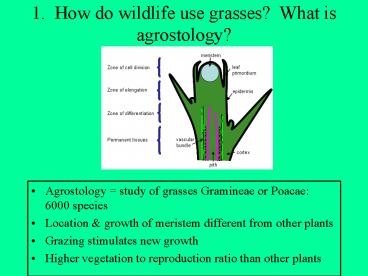1' How do wildlife use grasses What is agrostology - PowerPoint PPT Presentation
1 / 22
Title: 1' How do wildlife use grasses What is agrostology
1
1. How do wildlife use grasses? What is
agrostology?
- Agrostology study of grasses Gramineae or
Poacae 6000 species - Location growth of meristem different from
other plants - Grazing stimulates new growth
- Higher vegetation to reproduction ratio than
other plants
2
1) Cool vs warm season grasses
- Cool-season grasses Warm-season grasses
- 65-75oF 80 to 95oF
- Grow best in spring and fall Grow best in summer
- Limited winter dormancy Extended winter dormancy
- Good winter tolerance Poor winter tolerance
- Adequate shade tolerance Poor shade tolerance
- Examples Kentucky bluegrass, Bermuda, zoysia,
indian grass - tall fescue, perennial ryegrass, crabgrass,
corn - creeping bentgrass big, little bluestem,
3
2. Describe the practice of managing range
areas for wildlife
- Problem w/ brush climate or human activities
have increased brush, multiflora rose black
locust (IL), mesquite (west) - Domestic grazers cattle wont eat
- Sheep, goats horses will eat brush
- Wildlife depend on brush for Cover, food Deer,
Bobwhite quail, pheasants, turkey
4
2) Removal
- mechanical method
- Mowing
- Bush hog brush cutter
- Kills wildlife
- Herbicides
- Spray chemicals to kill
- Hand or machine
5
2) Removal, cont
- Negative impact of herbicides
- Can affect beneficial forbs and grasses.
- Herbicide drift
- Impact species other than target
6
2) Removal cont sage grouse case study
7
2) Removal by fire
- fire as a management tool
- Grasses survive
- Brush and small trees die
- Most grasses protected growing points near or
below ground - Grasses regrow rapidly
- Burning causes loss of 1 year of growth, decades
for shrubs/ trees.
8
3. How does overgrazing impact habitat and other
organisms?
- Wildlife usually more minimal impact than
domestic stock (pop size) - Wildlife increased variety of grasses, forbs
and shrubs - Cattle primarily grasses
- Goats, sheep, horses, can overgraze more than
grasses.
9
3) overgrazing
- Condition of field w/ good vs poor cover.
- What is the impact on various species?
10
3) overgrazing
- Overgrazing impacts wildlife
- Smaller antlers or none on overgrazed lands
11
Overgrazing impact on wildlife
12
3) Overgrazing may impact income eventually
13
4. What is the impact of grazers on other
species?
- Overgrazing increase in prairie dogs and ground
squirrels - Goats, sheep, cattle alter land for other grazers
- Leave some land un grazed if wildlife is wanted
- Grazed land increased erosion impacts on stream
organisms as well as land life.
14
5. How do rangefires affect wildlife?
- Fires frequent in prehistory Giant sequoia rings
indicate every 10 20 yr fires - Most wildlife unaffected unless fire walls
started - Move out of the way ahead of the fire
- Shelter in creeks, lakes rivers
- Burrow underground
15
Range fires cont
- Can improve habitat for some species
16
6. How does fencing influence wildlife
populations?
- Barb wire minimal except to young
- Woven wire for sheep, cattle horses barrier to
much wildlife - Big problems in africa, wildebeest, zebra
elephants destroy fencing when moving from
watering holes, fences interrupt natural cycles
17
7. What is the fate of burros horses?
- Bad BLM Bureau of Land management
- Kill horses and burros competition w/ antelope
and other game species - Studies show not true. Horses browser, eat
undesireable plants allow better grazing for
antelope.
18
8. What is game ranching? Why important?
- Trophy hunting
- Deer, elk, bison,
- Animal husbandry (raising like domestics)
- Elk, Bison, Deer
- Ostriches, rheas, emus
19
9. How does disease impact rangelands?
- Tetse flies
- Giraffe, wildebeest, zebra immune, cattle NOT
- Brucellosis
- Less impact on bison, cattle NOT
20
13. Vocabulary
- BLM bureau of Land Management, program to kill
off burros and horses, allow free or minimal cost
of grazing to ranchers w/ cattle, oversee Indian
reservation lands. - Animal unit Animal units (AU) are used in the
permitting, registration, and the environmental
review process because they allow equal standards
for all animals based on size and manure
production. An AU is calculated by multiplying
the number of animals by an animal unit factor
for the specific type of animal. - Animal unit calculator
21
Vocabulary cont
- continuous grazing - one open field / herd, not
subdivided. Forage is grazed while it is growing
Stocking rate stocking density Selective
grazing - unpalatable weeds increase Patchy
grazing - overgrazing and undergrazing
-Overgrazing reduces forage availability
-Undergrazing reduces forage quality High
production per animal, low production per acre - deferred rotation system - one field is
subdivided into 2 paddocks, animals sequentially
graze paddocks, rest periods. Up to 60 paddocks,
but 6-12 more common. Forage rests before next
grazing, increase vigor. Stocking density
stocking rate / no. of paddocks High stocking
density reduces selectivity and patchiness Lower
production per animal, higher per acre.
22
Vocabulary cont
- high low system high intensity grazing to
reduce grass cover, then low improves quail
habitat. - grazing pressure number of animals per acre
varies with type of habitat and climate































